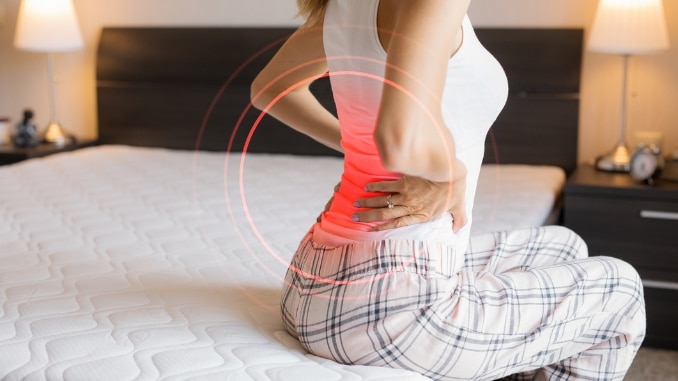Medical Disclaimer: The information in this blog is for enlightening and educational purposes only and is not intended as medical advice. The content in this post is not meant to substitute for a professional medical diagnosis, advice, or treatment. Always ask for advice from your physician or other qualified health providers with any questions you may have regarding a medical condition.
Back pain is extremely common [1], affecting nearly everyone, whether from sitting too long at work, poor posture, or daily activities that strain the spine. The good news is that regular stretching can help relieve stiffness, improve mobility, and reduce discomfort.
In this guide, we’ve combined the most important and easy-to-do exercises from Exercises For Injuries into one streamlined section.
According to Dr. Tony Matoska, PT, DPT, CMPT, of Athletico Physical Therapy, even just 5 to 10 minutes a day stretching your lower back is enough. He recommends doing these stretches before workouts or after long sitting periods.
Stretching [3] can :
- Help reduce pain.
- Improve muscle activity.
- Enhance recovery when combined with other rehab strategies.
1. Standing Back Arch
- Begin in an upright standing position with your feet shoulder-width apart, maintaining good alignment with your head, shoulders, hips, and legs.
- Place your hands on your lower back for support.
- Engage your core.
- Slowly arch your back, lifting your chest upward and slightly tilting your head back.
- Hold this position for several deep belly breaths, in through your nose and out through your mouth.
- Relax and return to the starting position.
- Perform 5 slow repetitions for 2–3 sets, focusing on form and comfort.
2. Seated Spinal Rotation
- Begin in an upright sitting position on a chair, maintaining good alignment with your head, shoulders, and hips.
- Place your hands lightly behind your head with your elbows pointing outward.
- Engage your core.
- Slowly rotate your upper body to one side, keeping your hips facing forward and your spine tall.
- Hold briefly, then return to the starting position.
- Repeat the movement on the opposite side.
- Complete the movement for 3 sets of 5 repetitions on each side.
3. Knees Side to Side
- Begin by lying on your back with your knees bent and your feet flat on the floor, hip-width apart.
- Maintain good alignment with your head, shoulders, and hips.
- Place your arms at your sides for support.
- Engage your core and slowly lower both knees to one side, keeping your upper body relaxed on the floor.
- Hold briefly, then bring your knees back to the center.
- Repeat the movement on the opposite side.
- Complete the movement for 3 sets of 5 repetitions on each side.
4. Double Knees to Chest
- For this stretches for back pain, begin by lying on your back with your knees bent and your feet flat on the floor.
- Maintain good alignment with your head, shoulders, and hips.
- Engage your core. Bring both knees toward your chest and clasp your hands just below your knees or on your shins.
- Gently pull your knees closer, looking for a light stretch in your lower back and hips.
- Hold this position for several deep belly breaths, in through your nose and out through your mouth. Relax and return to the starting position. Repeat the movement for 3 sets of 5 repetitions..
5. Single Knee to Chest Stretch
- Lie on your back on the floor and relax your upper body to start the stretches for back pain.
- Bend one knee and gently pull it in toward your chest, aiming for a light stretch in the lower back and pelvic area.
- For hand placement, if you experience knee pain, place your hands behind your thigh to pull the leg in from the hamstring area.
- If you are comfortable bending the knee further, you can place your hands on top of the knee instead.
- If keeping the opposite leg straight creates too much tension or discomfort in your lower back, bend that leg and keep the foot flat on the floor.
- This adjustment provides better support and allows you to perform the Single Knee to Chest exercise more comfortably.
6. Forward Fold
Use with caution if you have disc-related back pain.
- Begin in an upright standing position with your feet hip-width apart, maintaining good alignment with your head, shoulders, hips, and legs.
- Engage your core.
- Hinge forward from your hips and allow your upper body to fold down toward the floor, keeping your knees slightly bent for comfort.
- Let your arms and head hang naturally toward the ground.
- Hold this position for several deep belly breaths, in through your nose and out through your mouth.
- Slowly return to the starting position by rolling up through your spine.
- Perform 5 slow repetitions for 2–3 sets, focusing on form and comfort.
How to Use this Guide
- At Work: Try standing back arch and sit, and rotate to break up long sitting sessions.
- At Home: Add knees side to side, standing back arch, and forward fold to relieve stiffness.
- For Deeper Relief: Practice double/single knee to chest and pigeon pose regularly.
Key Benefits
- Relieves tightness from prolonged sitting.
- Increases spinal and hip mobility.
- Decreases stress on the lower back.
- Suitable for all levels, from beginners to desk workers needing quick relief.
Risk Factors
- Personal factors: People with less education, high stress, anxiety, or depression are more likely to have back pain.
- Work factors: Jobs that you don’t enjoy, lack of support from coworkers, or work that causes your whole body to vibrate (like driving heavy machinery) can increase risk.
- Age: Back pain [2] often starts in young adults (20s-30s), becomes most common around ages 60-65, and then slowly decreases after that.
- Life factors: Lack of physical activity, poor posture, heavy lifting, smoking, and has a higher weight can make back pain more likely.
- Health conditions: Osteoporosis, arthritis, and previous injuries to the back may increase risk.
- Psychosocial factors: Low social support, poor coping skills, and high job or family stress can worsen symptoms or make recovery slower.
Final Thoughts
Back pain doesn’t have to keep you from enjoying life. With these 6 simple and effective stretches for back pain, you can find relief at your desk, at home, or anywhere you have a few minutes to move. Consistency is key — practice these stretches daily and you’ll feel looser, stronger, and freer to move.
Take care of your back today, and it will take care of you tomorrow! Your most common daily habits are contributing to your back pain. But, once you understand how and why, and you make some easy adjustments, you can start supporting and strengthening your back. It will go back to moving and feeling naturally good! Check out this 7 Best Daily Habits for a Healthy Back.
Frequently Asked Questions
Should you stretch when you have back pain?
Yes, gentle stretching can help when you have back pain because it loosens tight muscles, improves circulation, and supports recovery. However, if the pain persists or gets worse during movement, it’s best to stop and consult a physical therapist. Stretching should be paired with exercises that strengthen the core and surrounding muscles to support the spine.
What stretches get rid of back pain?
Some stretches that may ease back pain include:
- Hamstring stretch: Lie on your back with one leg straight and the other leg lifted. Gently pull the leg toward you until you feel a stretch in the back of your thigh.
- Knee-to-chest stretch: Pull your left knee toward your chest while the opposite leg stays extended on the floor. Switch to the opposite side for balance.
- Seated twist: Sit with one crossed leg over the other leg, place your elbow on the opposite knee, and rotate your torso in the opposite direction. This helps release stiffness in the spine.
What is the 30-second stretch that relieves back pain?
A gentle forward fold can help. Stand tall, hinge at the hips, and let your arms hang naturally toward the floor for 20–30 seconds. This decompresses the spine, stretches the hamstrings, and relieves pressure that often contributes to both back and neck pain.


